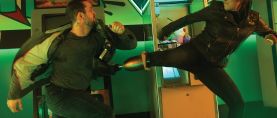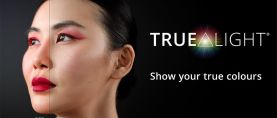
The Lost City of Z: Time Immemorial
Cinematographer Darius Khondji, AFC, ASC reteams with director James Gray for this period adventure — shooting 35mm film on location in Northern Ireland and Colombia.
Unit photography by Aidan Monaghan
There’s a scene early in The Lost City of Z in which Percy Fawcett (Charlie Hunnam), a confident and capable — albeit undecorated — lieutenant in the British Army is commissioned by the Royal Geographic Society to journey to Bolivia. The year is 1906, and Fawcett is portrayed as a loving husband and doting father who enjoys the comfortable life of a provincial English socialite; an “unfortunate choice of ancestors,” however, has prevented him from penetrating the aristocracy’s inner circle. This assignment, he is warned, is far more than survey work. This is exploration in the jungle, and it may cost him his life — but success would change his lot considerably, and for the better. Fawcett reluctantly accepts the commission, and though he returns, he brings with him an obsession from which there may be no escape.
This obsession is the essence of the film, says cinematographer Darius Khondji, ASC, AFC, who reunited with director James Gray after their first collaboration on The Immigrant (AC June ’14). Fawcett, Khondji notes, “was like Don Quixote, reaching for a grail that was always just out of his grasp. This was a key idea we could pursue.”
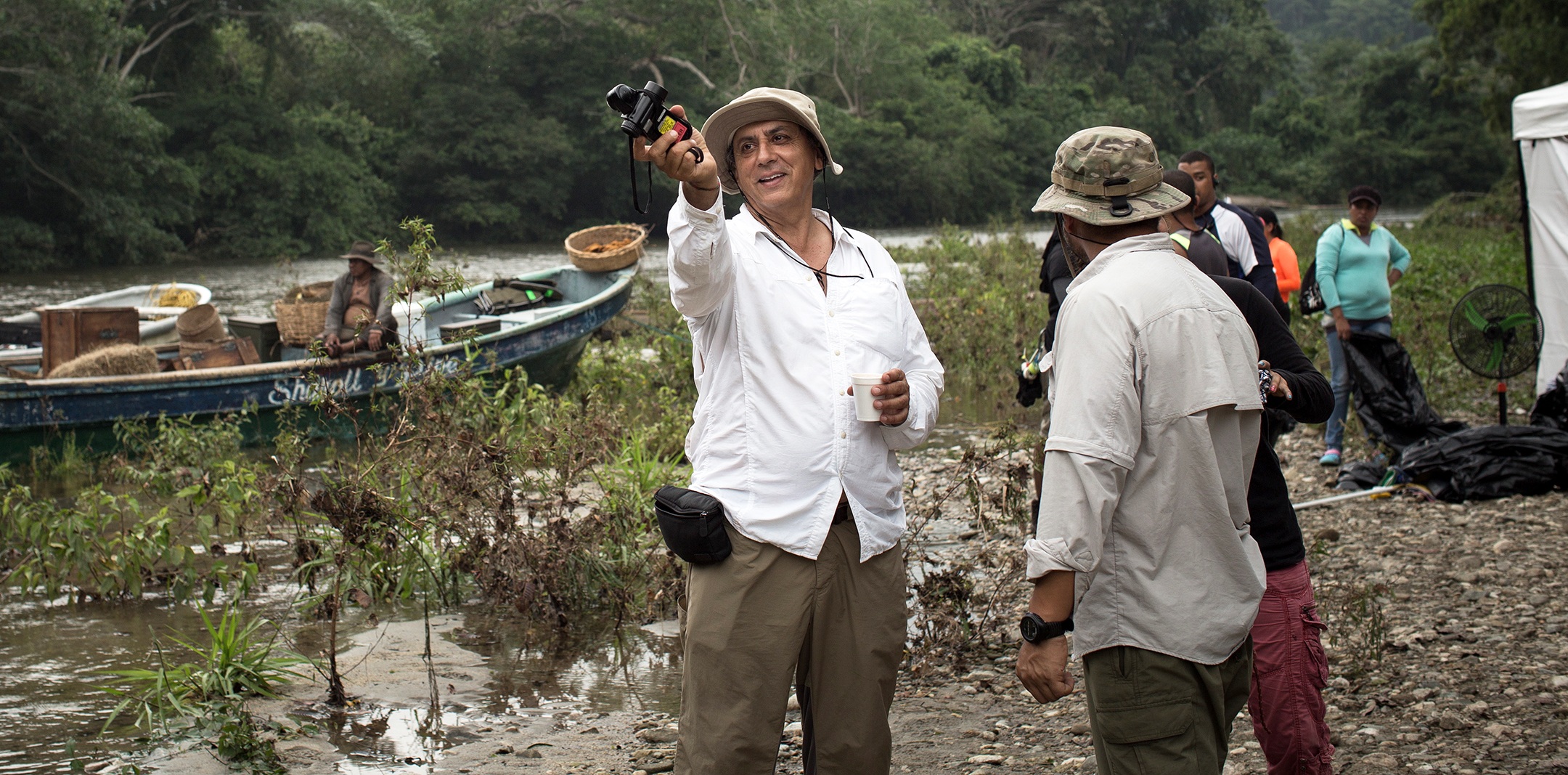
“The story is about the nature of obsession, with fits and starts because that was the rhythm of Fawcett’s life,” Gray adds. In adapting author David Grann’s book The Lost City of Z — which carefully recounted the history of Fawcett’s multiple journeys to the heart of the Amazon — the filmmakers focused on the episodic nature of the true tale. “We wanted to dramatize the emotion [of] coming and going,” says Gray, “and what kind of toll that obsession would take on the hero.”
Reviews of the resulting motion picture tend to regard it as classical in execution and straightforward in style. “James has a very modern sensibility, but the result is classic,” Khondji affirms.
But, Gray adds, that only describes the movie’s form. “Some films are made with a modern stylistic twist but are completely conventional beneath the surface,” the director notes. “Then there are the films that are made with a very traditional style, but they challenge our belief systems, our awareness of what’s true, and present a more complex world of motive and desire.”
Where The Immigrant had been the result of inspirations such as opera, cinema, photography and classical painting, Khondji and Gray wanted to be less reliant on outside references for The Lost City of Z. They focused primarily on the actual photographs from Fawcett’s expeditions, with additional inspiration found in the Naïve paintings of Henri Rousseau and the Baroque paintings of Claude Lorrain. “Rousseau’s paintings of the jungle have, we say in French, image d’épinal,” Khondji describes. “It means a very lush and almost childish image, filled with hidden things. It was more an inspiration for the idea of the jungle rather than the image itself. Our aesthetic inspiration came from the work of Claude Lorrain, who painted mythical images of skies filled with gold and red and blue.”

Khondji and Gray once again elected to shoot on film, using Kodak Vision3 500T 5219 stock — color-corrected in daylight with a Tiffen 812 Warming filter — for the majority of the production, with some sequences captured on Vision3 200T 5213 and 50D 5203.
“I’m a fan of digital, and I’ve played the devil’s advocate for digital in the past if I thought it was right for the production,” says the cinematographer. “It’s at least important to bring up the option of shooting digitally, but I’m a film-lover. It’s a modern medium, I’m excited to shoot on it, and I will defend it when we want it.”
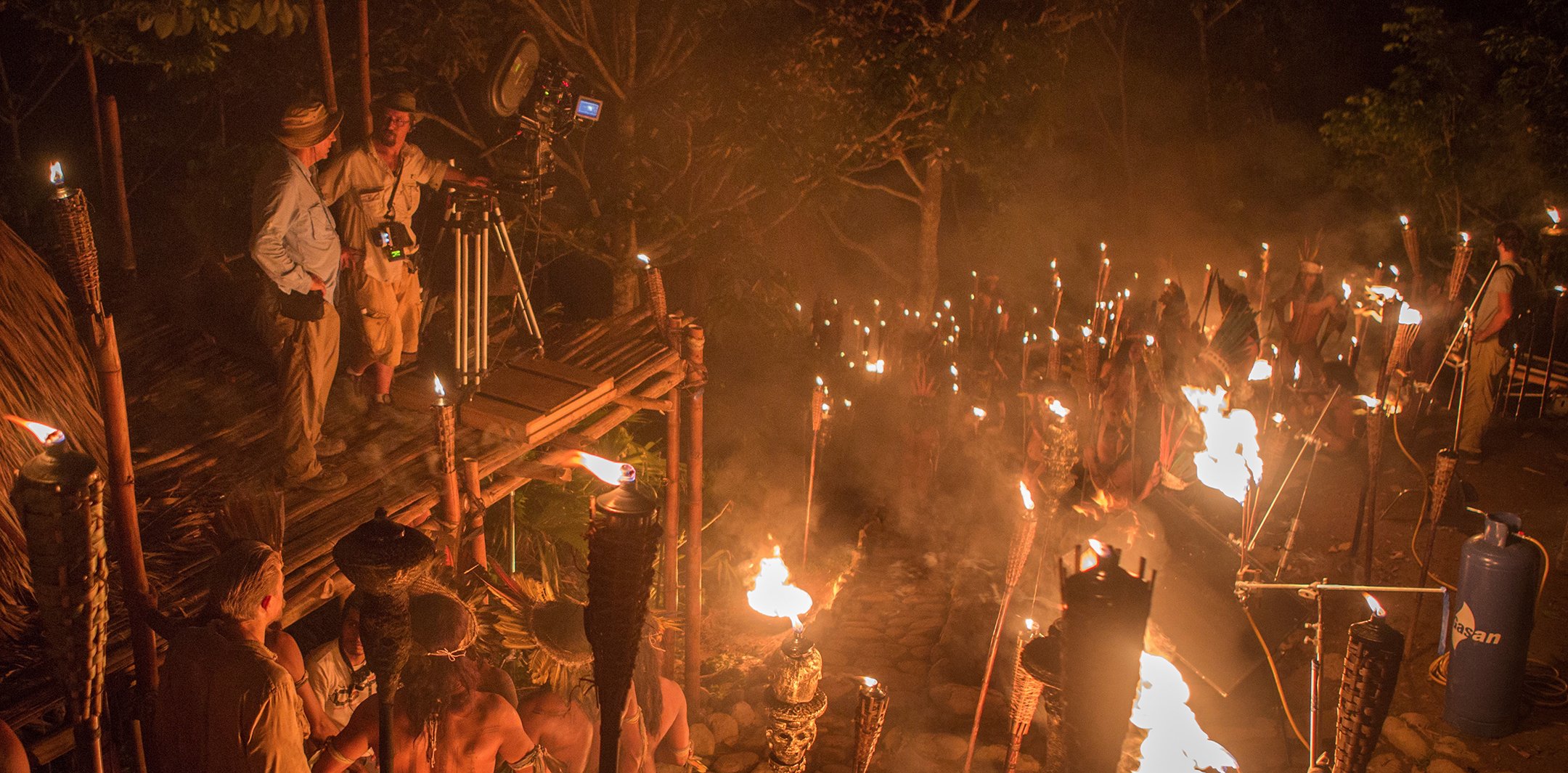
Early on, though, Khondji did consider shooting night exteriors in the jungle digitally. While prepping the first half of the shoot in Belfast, the cinematographer shot firelight tests with both Arri’s Alexa digital camera and 5219 film, pushing the film stock up to 2 stops. “There was hardly any difference at first glance, but when we got closer on the skin we saw little things that we liked better on film,” Khondji recalls. “Working with film feels more organic. I can push the negative, I can flash it like we did with The Immigrant — and we took flashing much further this time.”
Khondji’s film flasher of choice is Arri’s VariCon, a peripheral unit that occupies two filter slots in an Arri MB-14 matte box. The VariCon uses a variable color and intensity light source to illuminate a glass filter that fogs the image, raising detail and sensitivity in the shadow areas without affecting the midrange or highlights. Khondji knew a large portion of The Lost City of Z would be lit by warm firelight, and he used the VariCon for the film’s night exteriors as well as day and night interiors to cool the shadows, giving the negative a blue record that colorist Yvan Lucas could later manipulate in the digital intermediate.
As preproduction continued, Khondji shot his own anamorphic tests. “You’re talking to a lens fanatic,” he admits, then proceeds to outline his philosophy for selecting optics. “When you choose anamorphic lenses you have to choose the nicest ones, which aren’t necessarily the cleanest and the sharpest — they’re the most atmospheric. If you were to photograph the same face with five different 50mm anamorphic lenses, you’d see what I mean. The face will be thinner or fatter, or shrunk or expanded.”
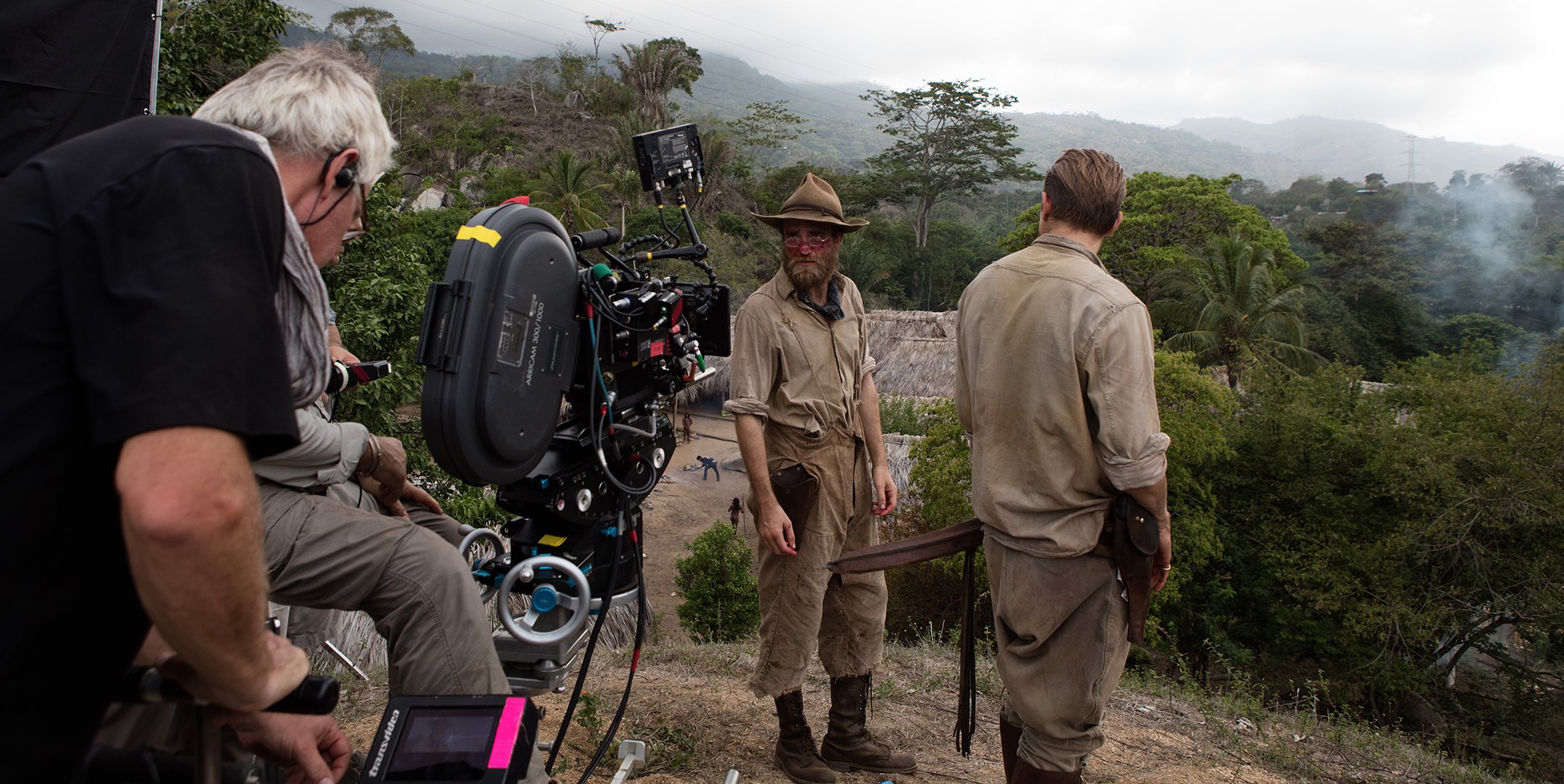
For The Lost City of Z, Khondji wanted to shoot his close-ups using a wide-angle lens, but without deforming faces, so he asked ASC associate Dan Sasaki — Panavision’s vice president of optical engineering and lens strategy — to optimize a 50mm C Series prime for close focus. First AC Eric Swanek worked with Panavision London’s Charlie Todman to round out the lens package with stock C Series, 135mm and 180mm E Series, and assorted USG anamorphic primes, as well as an AWZ2 40-80mm (T2.8), an ATZ 70-200mm (T3.5), and an anamorphized Angenieux 25-250mm HR (T3.5) zoom. Panavision London also provided the production with its cameras, including an Arricam ST; two Arricam Lites; and, as a backup camera set to a 172.8-degree shutter, an Arriflex 435 Advanced.
The lenses had to be fast to accommodate shooting by firelight, and Khondji’s preference for working at or close to the widest aperture. “With anamorphic I always shoot between T2.5 and T2.8,” he comments. “With my first movies — Delicatessen, The City of Lost Children and Alien: Resurrection — I was working with Jean-Pierre Jeunet, who loves deep depth of field. But James and I like having backgrounds that aren’t very sharp; [it creates] a feeling of 3D in a way, because of the various levels of depth.”

As prep gave way to principal photography, the filmmakers quickly realized that they had a very small budget with which to make a very big movie. “The Immigrant was good preparation for a movie like Z,” Khondji offers. “It was a period movie set in New York, and we made it for 12 million [dollars].” Though the budget for The Lost City of Z was closer to 30 million, the filmmakers had to make it look like twice that amount on the screen. “Our budget runs out about halfway through the script,” the cinematographer quips. The production was forced to cut costs wherever they could in order to channel much-needed time and resources where they were needed most. As a result, the filmmakers would shoot in Northern Ireland instead of England, and Colombia instead of Brazil. Furthermore, Gray’s script reduced Fawcett’s eight Amazonian expeditions to three.
With Game of Thrones also filming in Northern Ireland, lighting-equipment rentals in Belfast were extremely limited, so U.S. gaffer Frans Weterrings supplied a portion of the gear from his company Red Herring Motion Picture Lighting in Massachusetts, and Irish gaffer Seamus Lynch coordinated the rest with Pinewood Studios, outside London. Principal photography was scheduled for 55 days, beginning with practical interiors around Belfast, which stood in for London at the turn of the 20th century. (The only shot made in London was an exterior of the Royal Geographical Society headquarters.) All the scenes set in Devonshire, in the south of England, were shot in the countrysides around Belfast.
The Lost City of Z opens on one of those countrysides, with a scene in which Fawcett takes the trophy in a grand stag hunt. It’s the film’s first example of Gray’s objective correlative, a statement that Western European life accommodates brutality under the pretense of civility. To that end, “James wanted the hunt scene to feel rough and organic,” explains Khondji, “not clean or beautiful. Very medieval and raw.”
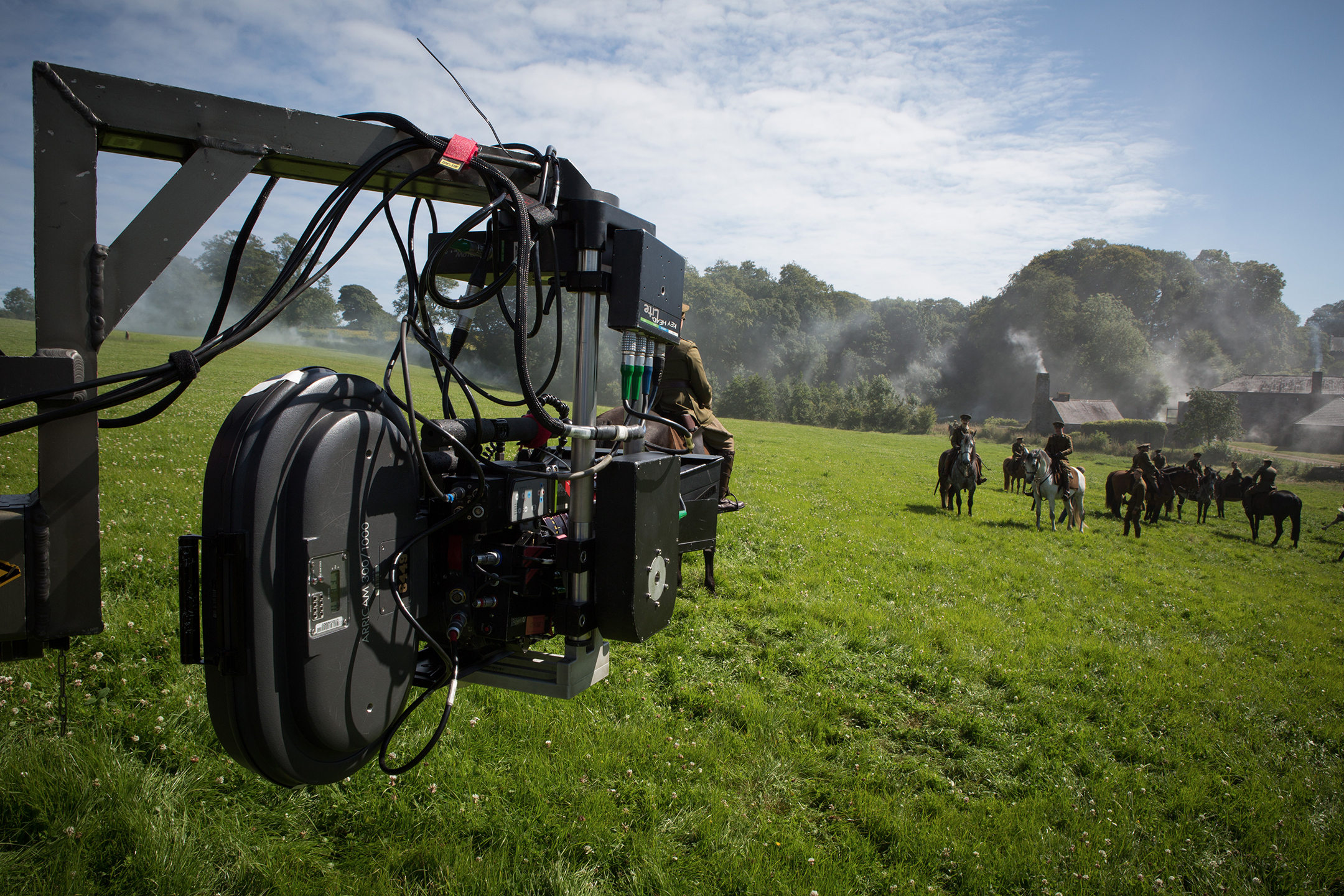
The scene is also one of the film’s key set pieces. “It was absolutely crazy to shoot,” Gray recalls. “At the time you write the script, you’re in your home and you write a line — ‘Exterior, Irish countryside, hunt’ — without really thinking about what it’s going to take, and the next thing you know, you’re standing in the middle of some field with dogs and horses.” A full-scale mock hunt was staged by some locals, and it took five days to film, with three cameras on the ground and one camera, an Arriflex 35-III, in the air, rigged to a helicopter-mounted Wescam system.
Shortly after this hunt, Fawcett makes his first journey to South America. On this expedition, rumors of an ancient golden city deep within the jungle mingle with the concrete evidence of archaeological finds in remotest Amazonia, leading Fawcett, upon his return home, to publicly suggest the possibility of a lost advanced culture — and with it a lost city, which Fawcett dubs “Z” — that predates Western civilization. This notion of an advanced “savage” alternately amuses and offends the public, but also garners interest enough to support a second voyage, this one with the sole purpose of finding Fawcett’s lost city.
The second expedition is cut short after one of its members, James Murray (Angus Macfadyen), succumbs to the jungle’s torments, his mind and body alike threatening to break, and lays waste to his fellow explorers’ supplies. Fawcett returns to England, where the outbreak of World War I pulls him back into active service, and he goes on to take part in the decisive Somme Offensive of 1916. “It was another way for us to show that the righteousness of Western civilization and civilized behavior was open to question,” Gray notes.
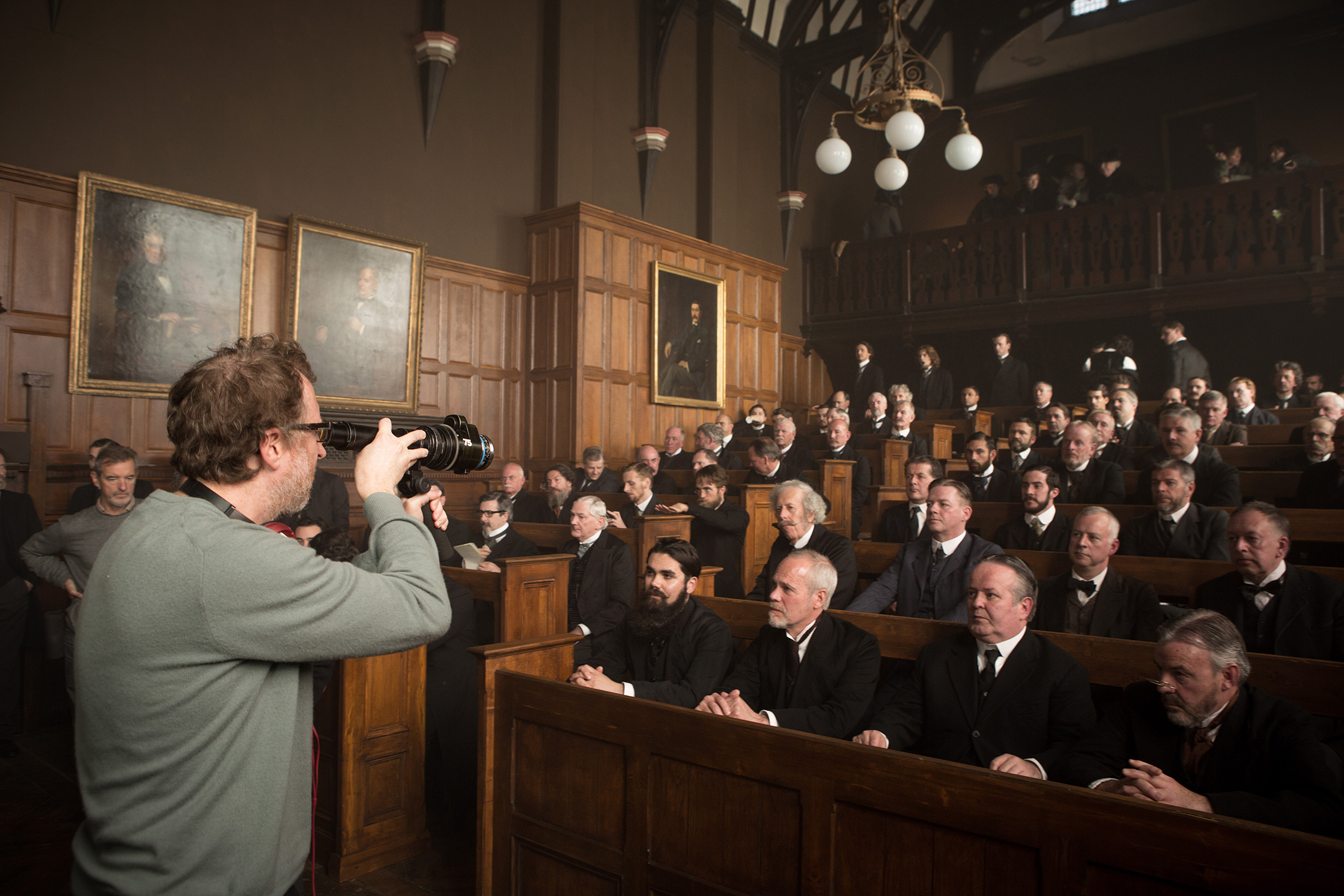
According to Khondji, “A lot of the Somme was shot handheld, running with the camera, very down and dirty. We didn’t want to do any big crane shots or big camera moves.” The cinematographer was inspired by Georg Krause’s camerawork in Stanley Kubrick’s Paths of Glory as well as a visit to London’s Imperial War Museum, where he, Gray and production designer Jean-Vincent Puzos researched weapons, uniforms, equipment, diaries and letters, keepsakes and trinkets, photographs, film, and art related to one of the bloodiest wars in human history. “It was more like a horror museum,” the cinematographer remarks. “It showed us how to render a battle scene, to make it look sad and deadly: desaturated, with lots of gray, like charcoal.”

The bunkers are dark and damp, with holes scraped into their sides, permitting shafts of light to break up the background. The soldiers sneak a Russian fortune-teller into one of these grim foxholes, where she seems to read Fawcett’s thoughts of Amazonia, which she describes as “a vast land bejeweled with peoples.” Fawcett replies, “Our world has set itself afire. I must look elsewhere to quench the blaze” — apt words to describe the filmmakers’ depiction of the Western Front, blasted and smoky and shimmering with the heat of battle thanks to flame bars that special-effects supervisor David Roddham placed beneath the lens.
All three of Fawcett’s visits to the “vast, bejeweled land” were filmed in the Colombian department of Magdalena, along the north slope of the Sierra Nevada de Santa Marta mountains and close to the Rio Don Diego. Puzos and his art department built all of the Colombian locations’ sets, including the villages, the rubber plantation Fazenda Jacobina, and the British Embassy.
It was in the jungle that the filmmakers simplified their approach. “We had lenses, sticks and a dolly, but no cranes or big lights,” says Khondji. “Because we shot film, we didn’t have all of these monitors and workstation cables and things. We just had film stock, a couple of cameras, and lenses.”
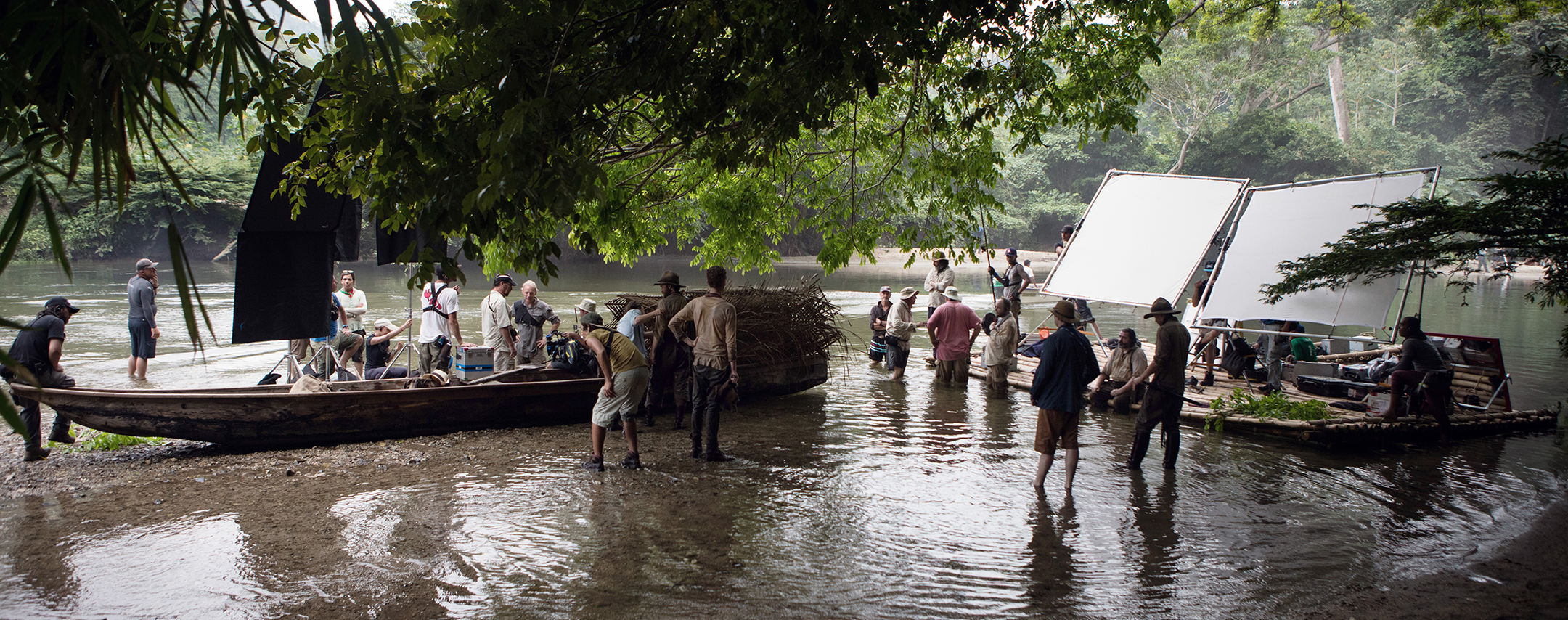
Natural light was augmented with rentals from Equipment & Film Design in Bogotá and Quixote Boston. Because the Colombian government would not allow the production to airlift generators into the jungle, Khondji and Weterrings had a dozen small 6,500-watt generators trucked in with MacTech LEDs, Octobanks, K 5600 Joker-Bug 800s and 400s, and homemade LiteGear LED assemblies.
The jungle sequences were filmed all along the Rio Don Diego. A normal commute from the equipment truck involved taking a half-dozen 14' boats up the river — sometimes through rapids — to a base camp, and then humping the gear to the set. “If we could get a 6,500 [generator] near set we could bring in the M40 HMI, which enabled me to extend our day with soft light,” says Weterrings. “If not, the [battery-powered] MacTechs were used.” The production was structured in the European fashion, with key grip Benoît Theunissen in charge of moving the camera and dolly, and Weterrings and rigging gaffer Josh Dreyfus in charge of rigging bounces and overheads.

Along with Rousseau’s images d’épinal, the Royal Geographic Society’s photos from Fawcett’s expeditions inspired Khondji to take an extreme approach to photographing the Colombian jungle. “There’s a photo of the explorers sitting in a group in the middle of the trees, with beards and big hats, and they’re covered in filth — they look completely destroyed by nature,” Khondji describes. “That made me think that in the jungle we should try to destroy the negative, to make it feel like they’re in the s---. I underexposed in some scenes, and overexposed up to 2 stops in others, so the grain starts to really blow up and you lose detail.”
The filmmakers suffered their own struggles with Colombia’s balmy equatorial elements. “We all lost weight in the jungle,” says Khondji. “Ninety to 100 degrees Fahrenheit, 100-percent humidity. Snakes and spiders and mosquitos. A hard shoot.”
Magdalena’s rainy season takes place between April and November. The Lost City of Z filmed there for six weeks, from September to October, with half of that time spent on the river shooting raft to raft. There were days when the production had to walk their rafts down the river because the water was too shallow, and days when massive thunderstorms would roll down off the mountains and the river would rise as much as 10', damaging and sometimes completely washing away base camps and sets.
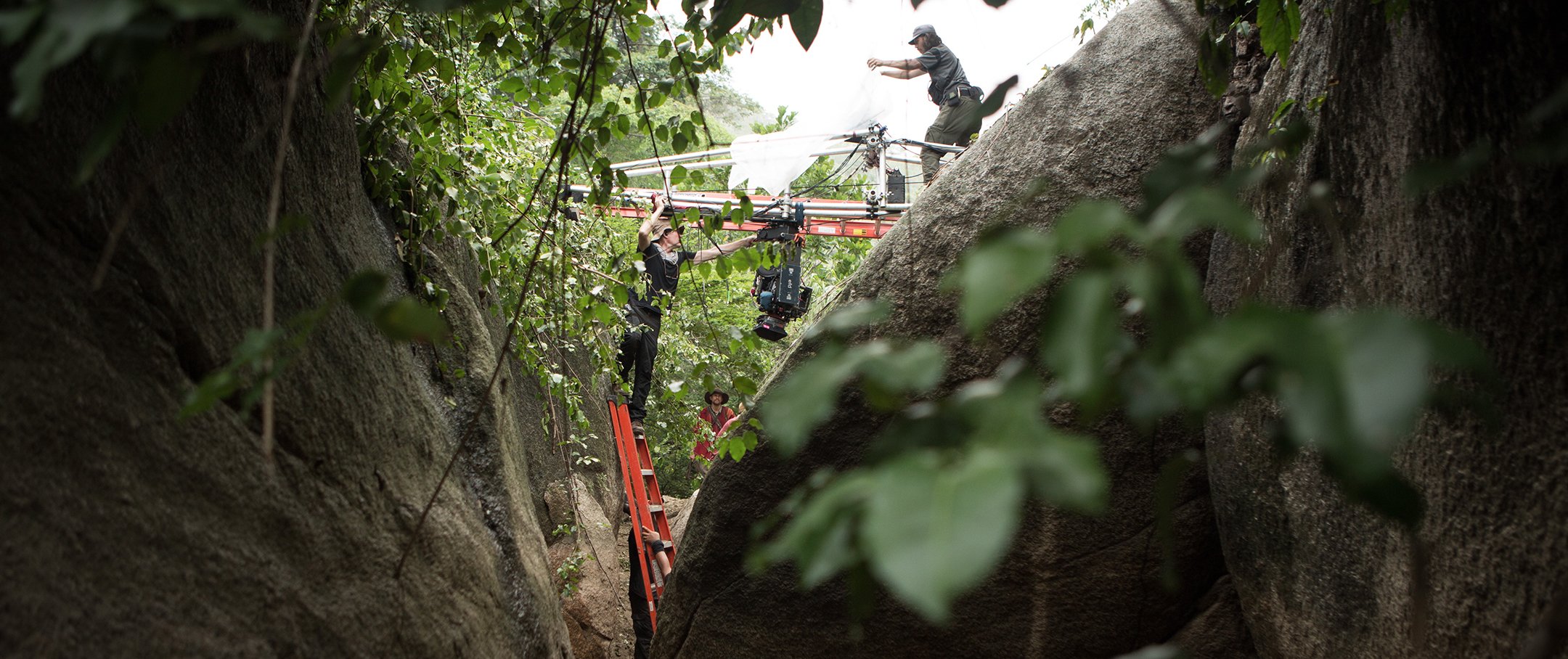
Khondji and producer Anthony Katagas attempted to convince Gray that a Steadicam would make it easier to endure the jungle’s uneven terrain and unpredictable weather, but the director held firm to his commitment to dolly moves only. “Benoît laid tracks everywhere, and the movie looks very different than it would have if we’d shot with a Steadicam,” says Khondji. Gilbert Lecluyse, a.k.a. “Berto,” was the production’s A-camera operator.
One of the sets hit hardest by inclement weather also required the most resources: the sprawling Fazenda Jacobina, home to a powerful Spanish rubber baron (played by Franco Nero) to whom Fawcett and attaché Henry Costin (Robert Pattinson) must appeal for assistance. It’s nighttime when Fawcett and Costin arrive at the remote plantation, and they’re greeted with an open-air Spanish opera staged upon a makeshift platform and illuminated by firelight. “The idea was to design a red jungle, a fake jungle, inside a real green jungle,” says Puzos. “The backdrop of the set is painted with trees and leaves. The idea was that it’s part of a hallucination, to guess what is real, what is not.” Using space lights, flame bars and strips of MR16 LEDs, Khondji matched Puzos’ colors with his own gold and red tones.
When the crew wasn’t evacuating under the threat of torrential thunderstorms, Khondji lit the nighttime locale with everything they had on hand, including flame bars, Octobanks fitted with LiteGear LEDs, MacTech LED units, covered wagons, Jem balls, and nine-lights. Wide shots of the compound were lit with 12-light Maxi-Brutes on a Genie Z-135 cherry picker, and a 20K atop a 40' scaffolding.
Each venture into Amazonia further ossifies Fawcett’s determination to locate his lost city, and as his search for the truth of Z takes him farther from home, his connection to the realities of Western life becomes increasingly tenuous. The filmmakers reflected this change with a gradually increasing sense of poetic detachment. As examples, Gray points out scenes such as the one where Fawcett watches his elder son Jack (Tom Holland) hunt a rabbit to the strains of Gabriel Fauré’s “Requiem,” or the idealized depictions of Amazonian natives welcoming Fawcett on the occasion of his fateful third expedition, on which Jack has joined him. “All of that was an attempt to introduce a lyrical aspect into the film as it progressed,” explains Gray. “As Fawcett’s life unfolded there was a level of understanding that he seemed to come to, especially towards the end.”
Fawcett and Jack’s earthly journey reaches its terminus in an isolated village of headhunters, who capture the two explorers and, in a nighttime torch-lit ceremony, carry them down from the mountain to the river “to find a home for their spirits.” The scene was designed by Khondji and Puzos after they discovered there was no manner of road by which to bring a generator into the area. As a result, Khondji reveals, “We designed the scene to be lit entirely with fire and torches. No electrical light at all.” Weterrings and Roddham held flame bars offscreen to accentuate the torches held by on-screen actors.
The VariCon, Swanek notes, “was not used during these final scenes. The humidity was so high that the filters were fogging and the photo-black tape used to hold the filter pack together wouldn’t stick.” Instead, Khondji simply pushed the film 1 stop to boost its sensitivity. “It doesn’t have that distressed look to it,” the cinematographer observes. “It was smoky so you see there is a texture, but with 5219, when you have deep blacks and high contrast, you don’t see so much grain. I pushed all of the jungle day [scenes] 1 stop, and the nights sometimes 2 stops.”
Getting the production’s dailies out of the jungle was an expedition all its own. Footage traveled from Santa Marta to Bogotá, then to the U.K. every two days for processing at Cinelab London, followed by coloring with Alex Gascoigne at Technicolor London. Yvan Lucas performed the final digital color grade at Shed in Los Angeles, by which point Khondji was shooting his next film, director Bong Joon-ho’s Okja.
Reflecting on the journey he and his collaborators undertook for The Lost City of Z, Khondji suggests that, essentially, they were after the same thing as Fawcett — the rediscovery of a lost time — although they went about their pursuit in a far different manner. “I could’ve never done this without James Gray,” the cinematographer stresses. “We entered this film on another level. On an adventure like this, you have to go with someone as crazy as you are.”
TECHNICAL SPECS
Anamorphic 35mm
Kodak Vision3 500T 5219, 200T 5213, 50D 5203
Arricam ST, Lite, Arriflex 35-III, Arri 435 Advanced
Panavision C Series, E Series, USG, AWZ2, ATZ
Digital Intermediate

